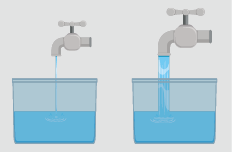Today, United Power enjoys a seat as one of the most progressive cooperatives across the country. Over the past 80 years, United Power has reached milestones few other cooperatives have, but not without first overcoming a few seasons of turbulence. This is the first in a three part series chronicling the cooperative’s history leading up to its 80th Annual Meeting this April.
In June 1938, shortly after Franklin D. Roosevelt created the Rural Electric Administration, a group of local farmers in the counties northeast of Denver met to discuss the possibility of forming a cooperative to meet their needs. In October of that year, Union Rural Electric Association was born. The cooperative began construction on lines that would first serve members in late January of 1940.
Though the outbreak of WWII paused development, growth continued through the 1950s. During that time, Union REA entered a competitive territory battle with the state’s largest public utility, Public Service Company of Colorado (now Xcel Energy), which had begun to see the areas lucrative potential. The battle over service territory would continue throughout the 1980s.
Legislation passed in 1961 finally recognized Union REA, and all other utilities in the state, as full-fledged public utilities with the right to serve certified territories, temporarily halting PSCo’s encroachment on the cooperative’s territory. However, Union REA agreed to allow PSCo to serve some of the fastest growing towns in its territory following a negotiation in 1964.
In the 1970s, PSCo broke faith with the cooperative as growth exploded in the area during that time. The public utility began aggressively claiming territory beyond what Union REA felt was outlined in the agreement. During that time, Union lost nearly 2000 accounts, and many more were considered “at-risk.” In 1987, the Public Utilities Commission declared the agreement invalid in favor of the cooperative, triggering PSCo to initiate a takeover attempt later that year.
Now more than 10,000 members strong, the cooperative’s healthy growth, combined with the proximity to the Denver metro area, made Union an attractive takeover target. PSCo offered to buy out the cooperative for $62.5 million and compensate members with a $500 cash payout to replace lost capital credits. Union REA leadership felt the offer was disingenuous, and communicated directly with membership until a vote on Saturday, August 22, 1987. Union members ultimately voted against the takeover, placing their faith in the promise of the cooperative future.


 You can fill the same 5-gallon bucket with either a garden hose, or a fire hose. A garden hose will not fill as quickly – but the hose costs less to operate, and the impact on the water system is minimal. Fill that same bucket with a fire hose, and it will fill up very quickly, but the surge of water from a fire hose requires larger pipes and a more expensive hose. In the end, both buckets would be full with the same amount of water, but filling a bucket more slowly – smoothing the water use over time – creates less demand on the system and costs less to do.
You can fill the same 5-gallon bucket with either a garden hose, or a fire hose. A garden hose will not fill as quickly – but the hose costs less to operate, and the impact on the water system is minimal. Fill that same bucket with a fire hose, and it will fill up very quickly, but the surge of water from a fire hose requires larger pipes and a more expensive hose. In the end, both buckets would be full with the same amount of water, but filling a bucket more slowly – smoothing the water use over time – creates less demand on the system and costs less to do.